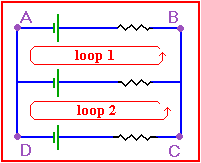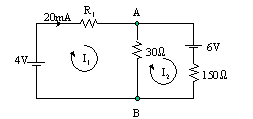|
|
In Electronics and with Matrices |
|
This site explores the solution of two simultaneous equations for two unknowns.
There are three different manners in which you may want to explore this site depending on your interest and needs. They can be interchanged or used by themselves.
Electronics
Application of Simultaneous Linear
Equations
Linear Simultaneous Equations are frequently encountered in electronics and technology. For example, when using Kirchhoff's Laws (KCL & KVL) for analyzing a circuit you eventually arrive at a system of loop equations that must be solved for CURRENTS I1 and I2. These two unknowns are solution to the network that is established by Kirchhoff's Laws.
Links to Kirchhoff's Laws
|
As per the diagrams to the right the SUM of the Voltage Terms in the loops should be ZERO. The three different currents are I1 , I2 and I3 with I3 = I1 + I2. Steps to solving Kirchhoff Law Equations. 1. Consider each loop as a seperate equation with I1 & I2 as variables to solve for. 2. Solve simultaneous equations for the unknown quantities. I1 & I2 Solving for the variables is described below. |
Loop 1 - Loop 2 = 0 |
A System of Equations has one solution. This solution is a set of ordered pairs of the form (x,y) that satisfies two or more equations. A System of Equations is generally of the (standard) form. It is helpful to arrange (rewrite the equations of the system) to look like the standard form:
AX + BY = C
DX + EY = F
and one ordered pair (x,y) satisfies these two equations.
Or in electronics
AI1 + BI2 =
C
DI1 + EI2 =
F
and one ordered pair (I1,I2) satisfies these two equations.
Example:
|
Eq 1. ) 3I1
+ I2 = 14 |
Using the example, we want to find a way to make the coefficient of either I1 or I2 equal so that we can isolate the other variable and solve for it. Try multiplying the entire Eq 1. by "3" so that we have
|
Eq 1.
) (3)3I1+ (3)I2 =
(3)14 |
|
Eq 1.
) 9I1+ 3I2 =
42 |
7I1 = 35
and so,
I1 = 5
Insert this I1 = 5 back into
either Eq. 1 or Eq. 2 and then you will be able to solve for
X.
Let's Insert it into Eq. 2.
|
Eq 2. ) 2I1 +
3I2 = 7 |
|
Eq 1. ) 3I1
+ I2 = 14 |
Systems of Equations in terms of x and y
and a SOLVER
Systems of Equations in terms of x and y and a SOLVER
A System of Equations has one solution. This solution is a set of ordered pairs of the form (x,y) that satisfies two or more equations. A System of Equations is generally of the (standard) form. It is helpful to arrange (rewrite the equations of the system) to look like the standard form:
AX + BY = C
DX + EY = F
and one ordered pair (x,y) satisfies these two equations.
One way to solve this system of equations is to graph both equations (make sure to set y = equation) and observe the intersection of the lines that are plotted. This intersection point is the ordered pair that represents the solution.
You can try this by hand on paper or by using a graphing utility like a graphing calculator, or even a tool available on the web.
Try this example by graphing it:
|
Eq 1. ) X+ 2Y = 10 |
Using the same example:
|
Eq 1. ) X+ 2Y = 10 |
Try multiplying the entire Eq 1. by "2" so that we have
|
Eq 1. ) (2)X+ (2)2Y =
(2)10 |
|
Eq 1. ) 2X+ 4Y = 20 |
|
5Y = 10 |
|
Eq 2. ) 2X - Y = 10 |
Try it out numerically by entering values here (remember to put "-" for a negative sign.) and then hit the "Solve" button.
top
Solver: Just
Enter your Coefficient Values and hit
solve
Solver: Just Enter your Coefficient Values and hit solve
Matrices and Cramer's Rule for Solving
a System of Equations
Matrices and Cramer's Rule for Solving a System of Equations
Solutions to systems of equations of the form
AX + BY = C
DX + EY = F
Can be found using the following:
X =
Y =
(AE - BD)
(AE - BD)
This method is derived from the determinants of matrices that can be arranged from a system of equations
Recall that a matrix A is of the form
|
[A] = |
| a |
b | |
|
| c |
d | |
a*d - c * b = determinant A
To solve a system of the form
AX + BY = C
DX + EY = F
1.) Find the determinants of the following matrices.
|
[A] = |
| a |
b | |
|
| d |
e | |
|
[Ax] = |
| c |
b | |
|
| f |
e | |
|
[Ay] = |
| a |
c | |
|
| d |
f | |
2.) Use the determinants to find the solution if determinant A is not zero.
|
X = |
|
|
|
|
||
|
Y = |
|
|
|
|
||

